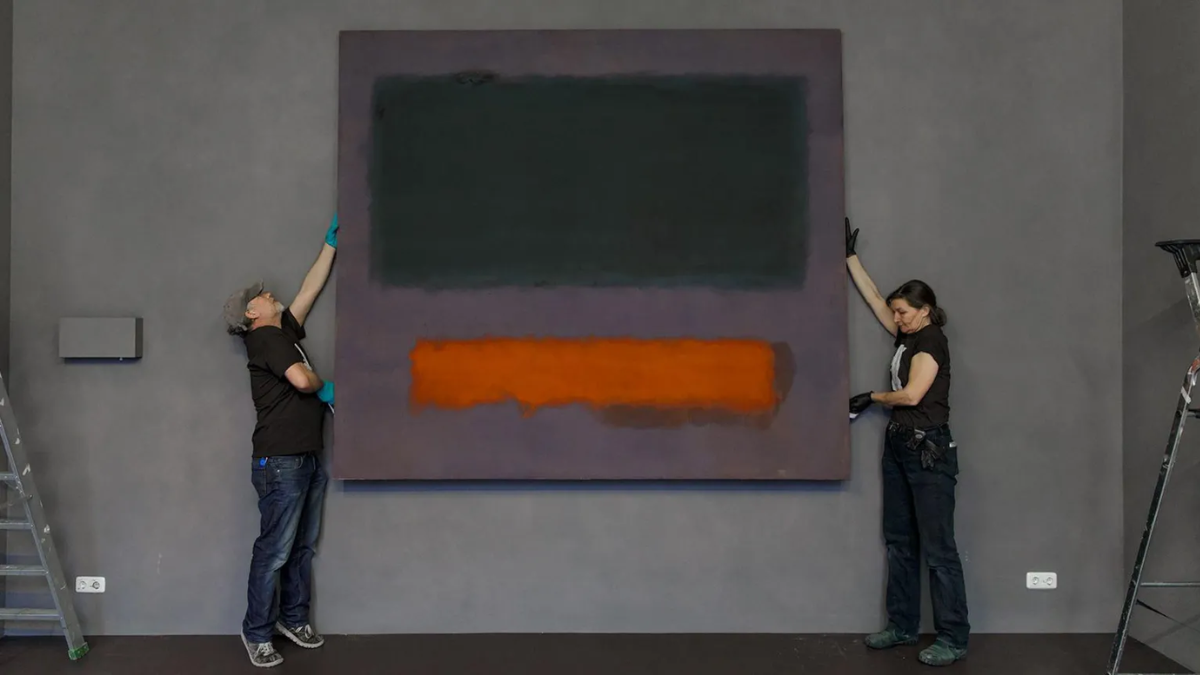A child has damaged a painting worth millions of pounds by the American artist Mark Rothko at a museum in Rotterdam.
A spokesperson for the Museum Boijmans Van Beuningen said it was considering the “next steps” for the treatment of Rothko’s Grey, Orange on Maroon, No. 8.
The damage occurred during an “unguarded moment”, a museum spokesperson told the Dutch media outlet Algemeen Dagblad (AD) last week.
A spokesperson for the museum told the BBC the damage was “superficial”, adding: “Small scratches are visible in the unvarnished paint layer in the lower part of the painting”.
The abstract painting is estimated to be worth up to €50m (£42.5m), according to newspaper AD.
“Conservation expertise has been sought in the Netherlands and abroad. We are currently researching the next steps for the treatment of the painting”, the museum spokesperson told the BBC.
“We expect that the work will be able to be shown again in the future,” they added.
Sophie McAloone, the conservation manager at the Fine Art Restoration Company, said that “modern unvarnished” paintings like Rothko’s Grey, Orange on Maroon, No. 8 are “particularly susceptible to damage”.
This is “owing to a combination of their complex modern materials, lack of a traditional coating layer, and intensity of flat colour fields, which make even the smallest areas of damage instantly perceptible,” she said.
“In this case, scratching of the upper paint layers can have a significant impact on the viewing experience of the piece,” Ms McAloone said.
The Rothko painting was hanging in the museum’s Depot – a publicly accessible storage facility beside the main museum – as part of an exhibition displaying a selection of “public favourites” from the gallery’s collection.
Jonny Helm, a marketing manager at the art restoration service Plowden & Smith, said the incident had implications for UK institutions such as V&A East and the British Museum, which are considering “opening up the display of things that would otherwise be obscured in archives.”
“How will this event affect other UK institutions who are opening up their archives in the same way?” Mr Helm said.
Restoring a Rothko painting is a difficult task because “Rothko’s mixture of pigments and resins and glues were quite complex”, Mr Helm said.
He said the fact the painting is unvarnished – meaning it is “open to the environment” – will pose an additional challenge to conservators.
Conservators working to restore the painting will now likely be in the process of documenting the extent of the damage and researching “historic successful treatments” of Rothko paintings.
“Rothko works seem to have terrible luck – this isn’t the first damaged Rothko we’ve heard about,” Mr Helm said.
Rothko’s 1958 work, Black on Maroon, was deliberately vandalised by Wlodzimierz Umaniec at London’s Tate Modern gallery in October 2012.
Umaniec was sent to prison for two years and subsequently apologised for his actions.
During his trial, prosecuting barrister Gregor McKinley said the cost of repairing the work would be about £200,000. It took conservators 18 months to repair the painting.
Rachel Myrtle, Head of Specie and Fine Arts at Aon, a company that offers insurance broking to its clients, said fine art insurance policies typically cover “all risks associated with physical loss and damage to artwork”.
This includes “accidental damage caused by children or visitors, albeit with certain exclusions”, she said.
She said that when an artwork is damaged, a gallery’s insurer will appoint a specialist fine art loss adjuster to visit the museum.
The loss adjustor typically “reviews the damage to the artwork, examines any CCTV footage to determine the exact cause of the loss, and assesses conservation options”, Ms Myrtle said.
The museum did not comment on who will be held liable for the damage to the 1960 painting, which the gallery reportedly bought in the 1970s.
The Museum Boijmans Van Beuningen has previously billed visitors who have caused damage to artworks on display.
In 2011, the museum asked an unsuspecting tourist who stepped on Wim T. Schippers’ peanut butter floor artwork, called Pindakaasvloer, to pay for repairs to the work.
Sharon Cohen, a spokesperson for the museum at the time, was quoted by AD as saying: “It is normal procedure for people to pay if they damage art.”
The Rothko painting is described by the museum as an example of colour field painting, a term used to describe art characterised by large blocks of flat, solid colour spread across a canvas.
Rothko’s Grey, Orange on Maroon, No. 8 painting is one of several works of modern art that have been damaged in the Netherlands in recent years.
In November 2024, multiple screen prints by the US pop artist Andy Warhol were damaged by thieves during an attempted robbery of the MPV art gallery in the town of Oisterwijk.
In another incident, a Dutch town hall admitted it “most likely” disposed of 46 artworks by accident – including an Andy Warhol print of the former Dutch queen – during renovation works last year.
Museums have different policies when responding to damage caused by children.
In August last year, a four-year-old boy accidentally smashed a 3,500-year-old jar into pieces at the Hecht Museum in Israel.
At the time, Hecht Museum worker Lihi Laszlo told the BBC the museum would not treat the incident “with severity” because “the jar was accidentally damaged by a young child”.
The family were invited back to the exhibition with his family for an organised tour shortly after the incident occurred.
(BBC News)

